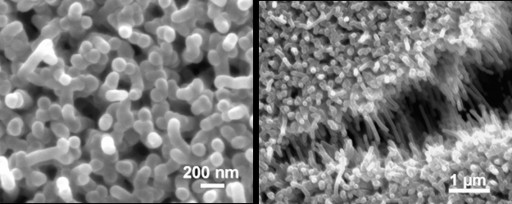Nanotube-based supercapacitor-battery works in extreme conditions
August 23, 2011

Bundles of coated carbon nanotubes are the heart of a solid-state supercapacitor developed by Rice University scientists for energy storage (credit: Hauge Lab/Rice University)
Researchers at Rice University have created a solid-state, nanotube-based supercapacitor that promises to combine the best qualities of high-energy batteries and fast-charging capacitors in a device suitable for extreme environments.
The Rice team grew an array of 15–20 nanometer bundles of single-walled carbon nanotubes up to 50 microns long. The array was then transferred to a copper electrode, with thin layers of gold and titanium to aid adhesion and electrical stability.
The nanotube bundles (the primary electrodes) were doped with sulfuric acid to enhance their conductive properties; then they were covered with thin coats of aluminum oxide (the dielectric layer) and aluminum-doped zinc oxide (the counter electrode) through a process called atomic layer deposition (ALD). A top electrode of silver paint completed the circuit.
The supercapacitor holds a charge under high-frequency cycling and can be naturally integrated into materials. The researchers envision an electric car body that is a battery, or a microrobot with an onboard, nontoxic power supply that can be injected for therapeutic purposes into a patient’s bloodstream.
They said the supercapacitor would be ideal for use under the kind of extreme conditions experienced by desert-based solar cells or in satellites, where weight is also a critical factor. Other potential uses span on-chip nanocircuitry to entire power plants, they said.
Ref.: Cary L. Pint, et al., Three dimensional solid-state supercapacitors from aligned single-walled carbon nanotube array templates, Carbon, 2011; 49 (14): 4890 [DOI: 10.1016/j.carbon.2011.07.011]